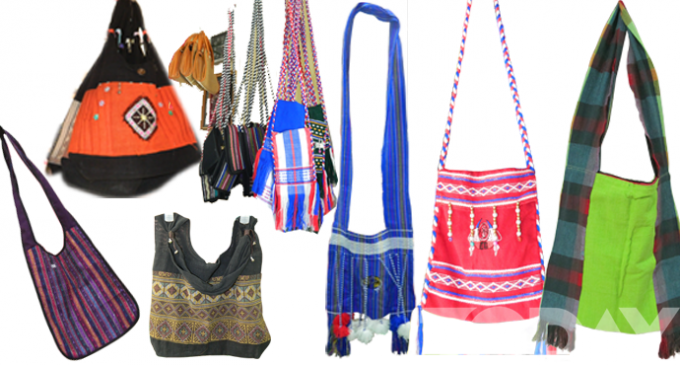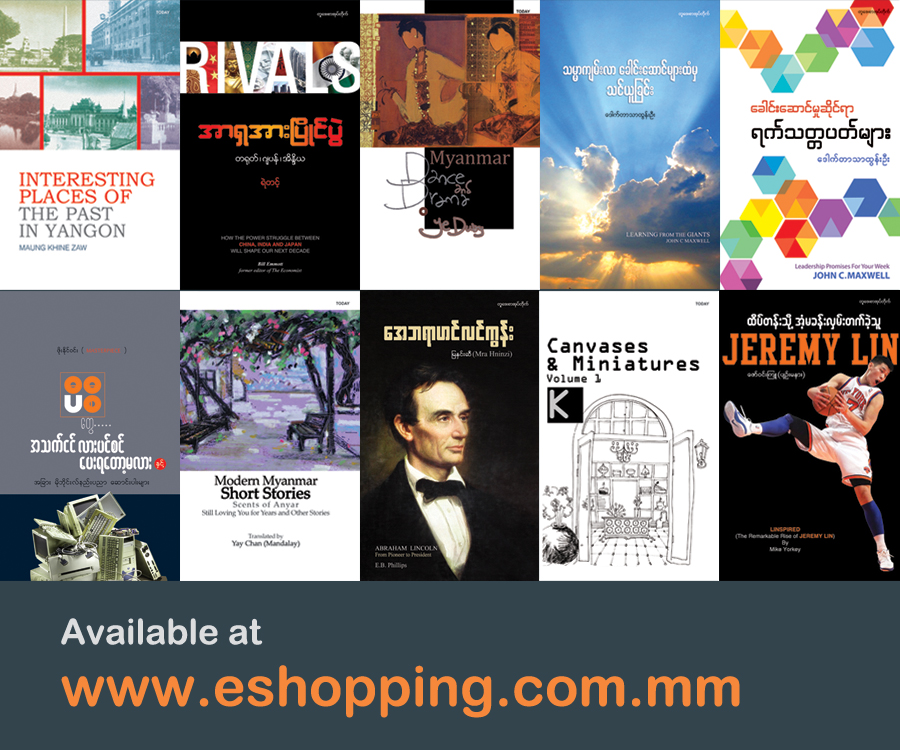IN PRASE OF THE MYANMAR SHOULDER BAG

One of the many products that attracts the attention of tourists visiting a Myanmar market is the Myanmar traditional shoulder bag. The standard size of the colourful bags is about one foot by one foot and they are woven on small hand looms or machine operated using cotton or wool. Thick yarns are used to weave them and sometimes it is fitted with an inner lining made of cotton to maintain their form even after years of use. Usually, the colour of the shoulder strap is black but it may be of the same colour as the bag. What makes the Myanmar shoul-der bag unique is the tassel of about three inch long at each side of the bottom of the bag. The bags come in a variety of colours with different patterns woven into them. The patterns consist of traditional designs of national races, simple geometric shapes like triangles, squares, circles, stripes, and wavy lines, creatures like birds, fish, Myanmar mythical animals, things like boats, trees, flowers, simple scenes, and human figures. In fact, any design, depending on the creativity and talent of the weaver or the preference of the customer such as your company’s logo can be incorporated.
The bags are generally known as lware eit shoulder bags or Shan lware eit meaning Shan shoulder bags. The bags are associated with the Shan national races living in Shan State located in the eastern part of Myanmar, as the state is well-known for its woven textiles, especially the Inlay lake area. The traditional Shan shoulder bag is made of pinkish brown colour hand woven cloth known as pinni but now bags of different colours are produced. Both the shoulder strap and the bag are usually of the same colour.
The shoulder bags are not unique to Shan State alone. Major national races out of the over hundred national races have their own style of shoulder bags. Kachin State located in the northern part of Myanmar is also well-known for its high quality woven shoulder bags. In fact, the shoulder bag and the sliver sword in a sheath have great significance in Kachin culture and is part of the ceremonial attire of the Kachin male. A shoulder bag and a sliver sword are presented to the groom by the bride on their wedding day, the sword signifying protection from danger and clearing the path of any obstacles and the shoulder bag symbolizing accumulation of wealth. There are two types of Kachin shoulder bag, the one for ceremonial use with silver discs and one for daily use. Myitkyina, the capital of Kachin State has now become a centre of weaving and sale of Kachin shoulder bags. In the past, nearly every Kachin household had a small hand loom called jut-khok and the families made their own shoulder bags. Kachin ladies claim that their weaving was so fine that even water cannot pass through the bag. Formerly the bags were made of yarn from the cotton grown in the region and silk yarn, but now they have been replaced with a mixture of cotton and wool yarn. The Kachin shoulder bags may come in a plain style decorated with simple diamond patterns or symbols used on manaw poles erected during the Kachin New Year festival which are like the totem poles of native Americans.They may be also elaborately decorated with silver discs, embroidery, cowries, beads and tassels which make them look extremely beautiful and they are very expensive.
Members of the Kayin national race who live mostly in Kayin State, Ayeyarwady Delta, Mon State and Bago Region are also known for their weaving skill and they also weave shoulder bags with diagonal stripes and the shape is similar to the Shan bag. Members of the Pa-oh national race who live in Shan State and other regions of Myanmar such as Kachin and Mon State also have their own style of shoulder bags. The bags are larger in size than the Shan bags and usually of red colour with thin white or dark blue diagonal stripes and no tail-like tassels at the bottom of the bag. The Kayah national race who live in the eastern part of the country also weave their own shoulder bags very similar to the Pa-oh shoulder bags. The shoulder strap of the bag and the colour of the bag would be of the same colour and the bag would be decorated with red, or green vertical stripes. The Kayah men like to take their shoulder bag as a holdall wherever they go. The Chin national race who live in the northern part of Myanmar has also its own style of shoulder bags. They usually weave their bags using the yarn produced from locally grown cotton on a small hand loom. The shape of the bags is slightly different from Kachin shoulder bags. They are long and narrow with a long shoulder strap. At one time, the patterns used in the weaving of the bag were very simple but now it has become very intricate by using the patterns used in weaving Chin shawls. Shoulder bags made in Mon State situated in the south-eastern part of Myanmar usually have the design of a hamsa bird and Mon letters woven on the bag. Shoulder bags are also made in Upper Myanmar, especially in centres of weaving such as Amarapura, a township in Mandalay Region, Seik Khun and Pakkoku in Magway Region but the designs are less elaborate.
Before the popularity of satchels, hand-bags, attaché cases, backpacks, sports bags, totes, suitcases, shopping bags, brief cases, and plastic bags, the shoulder bag was the main kind of bag used by the Myanmar people. As it is made of cloth, it is washable, reusable and environ-mentally friendly. Although it does not seem to be very big, you can use it as a travelling bag as it can accommodate a few set of clothes. You can use it to put your money in if you were a vendor, or you can carry your valuables and take them with you and nobody would notice it as one of my elder relatives does. Or you can carry your bronze or lacquer container for the betel leaves, betel nuts, other things you need to make a quid of betel and the betel nut cutter, if you are fond of chewing betel. Or, if you are an office worker you can carry your files in it. There are also shoulder bags especially designed for Buddhist monks and nuns.
The largest number of users of shoulder bags was and still is students who use them to carry their textbooks and stationary to school. Up until round about the year 2000, shoulder bags were used by students from the primary to the university level to carry books. However, in big cities, school children and university students now prefer to use other types of bags. While male university students prefer to use sports bag and backpacks, female university students like to use stylish-looking leather or synthetic leather shoulder bags to carry books, and they also like to carry tote bags at the same time. However, in smaller cities, towns and countryside, the tradition of using Myanmar shoulder bags to carry books is maintained and even some university students, especially males, continue to use shoulder bags to carry books.
Like youths all over the world, Myanmar young people also like to look stylish even in matters of shoulder bags. When shoulder bags were popular with university students all over the country, the bags were used to set trends. Female students would have shoulder bags of numerous colours to match their outfits. One trend that emerged was for female university students to decorate their shoulder bags with small objects like tiny dolls and animals to add a bit of glamour. Another trend was the use of shoulder bags knitted with wool and decorated with lots of tassels and bobbles giving a fluffy appearance. Another trend was to use bags with very long shoulder straps. Male university students also had their own trends. They used large Pa-oh style shoulder bags with the strap knotted. This was a style popularized by an actor portraying a university student in one of his films. Still another style of male students was to sling the bag with the shoulder strap across the chest with the bag hanging on the opposite side instead of the normal way of letting the bag hang on one shoulder. The current trend for males is to sling the shoulder bags in the traditional way or tie knots on the strap and wear across the chest.
Holdalls, attaché cases, tote bags, and plastic bags and other types of bags are gradu-ally taking the place of the traditional shoulder bags but there should be little concern that the Myanmar shoulder bags will become obsolete just like the way people in Myanmar have forsaken the traditional paper umbrella for daily use. This is due to the fact that not only do shoulder bags form a part of the traditions of some of the national races of Myanmar, but also from a practical point of view, they will continue to be used because they are affordable, they are light to carry, they can hold a lot of things, they are durable and they are attractive and stylish as any tourist who has been tempted to buy one will testify!
by Myo Myint
./wp-content/uploads/2018/10/Emirate-Online-TDY.png)
























There are no comments at the moment, do you want to add one?
Write a comment